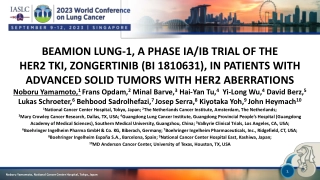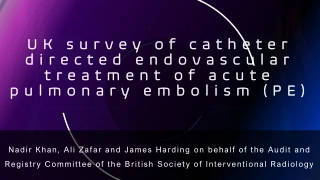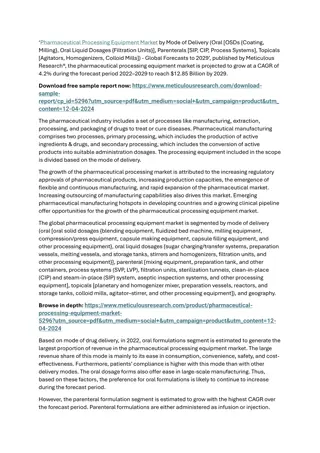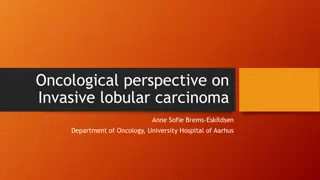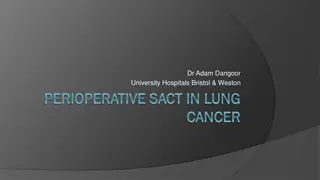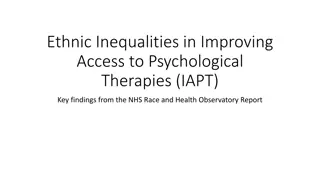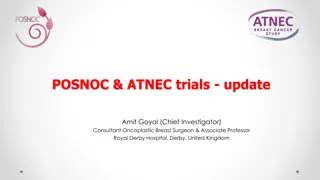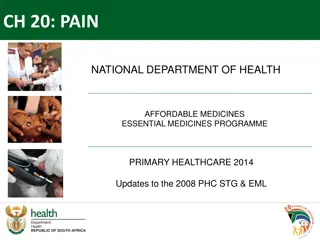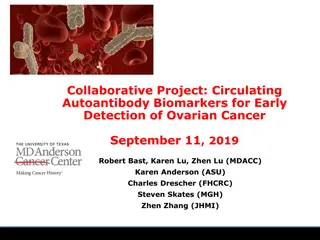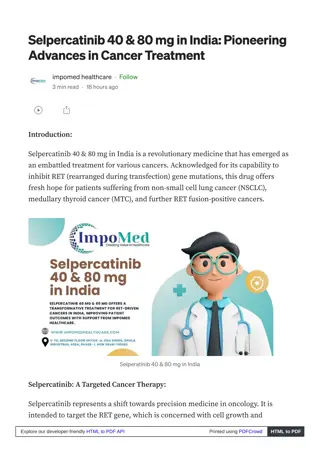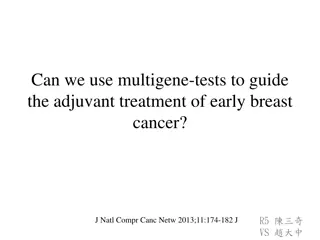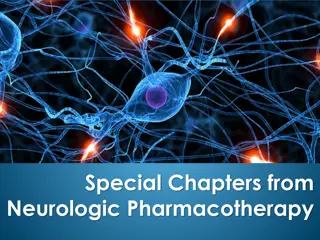Adjuvant Therapies in Early Stage NSCLC: A Review
Examining the role of adjuvant therapies in stage IB-IIIA non-small cell lung cancer (NSCLC) post-surgery. Discussion includes the impact of chemotherapy and radiation therapy on overall survival rates and the historical context of adjuvant treatment decisions. Management strategies and considerations for postoperative therapies in early stage NSCLC are explored.
Download Presentation

Please find below an Image/Link to download the presentation.
The content on the website is provided AS IS for your information and personal use only. It may not be sold, licensed, or shared on other websites without obtaining consent from the author.If you encounter any issues during the download, it is possible that the publisher has removed the file from their server.
You are allowed to download the files provided on this website for personal or commercial use, subject to the condition that they are used lawfully. All files are the property of their respective owners.
The content on the website is provided AS IS for your information and personal use only. It may not be sold, licensed, or shared on other websites without obtaining consent from the author.
E N D
Presentation Transcript
ANITA TRIAL ARIEL POLLOCK SINAI JOURNAL CLUB 6/1/17
CASE HPI: 69 yo male, former 50 pack year smoker, who had a 5cm RLL mass incidentally seen on CXR during a workup for inguinal hernia repair, now s/p RMLobectomy. He feels well and denies any cough, SOB, hemoptysis, anorexia, unintentional weight loss, fever/chills. ROS: all negative PMH: Afib, CD, BPH, OSA, HTN PSH: None Allergies: NKDA Meds:Ticagrelor, Atorvastatin, Tylenol, Metoprolol, Tumsulosin FHx: Noncontributory SHx: Former smoker, 50 pack years
CASE Physical Exam: BP 119/72, HR 65, T 97.9, RR 18, Wt 208lb, SpO2 96% General: Lively, appears stated age HEENT: No LAD Cardio: RRR, normal S1/S2 Pulm: CTAB, symmetric chest wall motion, no rales, rhonchi or wheezes Pathology: RML and margin, Level 7 LN AdenoCA, 7.0cm, does not invade visceral pleura. +LVSI N1 LN+ PDL1 0%; EGFR exon 20 insertion Imaging: (prior to surgery) PET/CT: RML mass 5cm, SUV 10.5. No definite hilar, axillary, mediastinal LAD
PICO Population: Patients with stage IB IIIA NSCLC Intervention: Adjuvant Chemotherapy Control: No Adjuvant Chemotherapy Outcome: Overall survival Does adjuvant chemotherapy improve overall survival in patients with stage IB-IIIA NSCLC?
NSCLC STAGING AJCC 7thEdition Stage Grouping Stage IA T1a 1b N0 M0 AJCC 4thEdition Stage Grouping Stage IB T2a N0 M0 Stage I T1 T2 N0 M0 Stage IIA T1a T2a N1 M0 T2b N0 M0 Stage IIB T2b N0 M0 Stage II T1 T2 N1 M0 T3 N0 M0 Stage IIIA T1a T2b N2 M0 Stage IIIA T1 T2 T3 N2 M0 T3 N1 N2 M0 T4 N0 N1 M0 N0 N2 N0 Stage IIIB T4 N2 N3 M0 M0 Stage IIIB Any T N3 M0 Any T Stage IV Any T Any N M1a M1b T4 Any N Any N M0 M1 Stage IV Any T
MANAGEMENT OF EARLY LOCALLY ADVANCED STAGE Accounts for ~30% of lung cancer cases Stages IA IIIA (this study excluded stage IB) Surgical resection was mainstay of treatment 5 year Overall Survival Stage IA Stage IB Stage IIA Stage IIB Stage IIIA 78% 58% 46% 36% 24% What about adjuvant therapies?
POSTOPERATIVE THERAPIES Adjuvant therapy = therapy (either chemotherapy or radiation therapy) after surgical intervention Meta-analysis in 1998 showed that post-operative RT was detrimental to patients with completely resected tumors Early studies did not show a benefit from adjuvant chemotherapy, thus it was not routinely used BUT
ADJUVANT CHEMO Meta-analysis in 1995 of all trials of adjuvant chemotherapy vs BSC (best supportive care) demonstrated 13% risk reduction of death with adjuvant chemotherapy (cisplatin-based) and absolute survival benefit of 4% at 5yrs But, this did not impact clinical practice because of heterogeneity of the studies included, non-significance, and lack of RCT The results prompted 8 different studies, including the ANITA trial
ANITA PRAGMATIC STUDY DESIGN Multicenter, multinational, randomized open control trial After surgery, patients received either chemotherapy (cisplatin + vinorelbine) or were observed PORT was left to decision of participating centers, but decided before patients were included in the trial Randomization and statistical analysis performed by Biometric Department of the IRPF Treatment allocation was not masked What are potential problems with an open trial?
ELIGIBILITY Inclusion Exclusion Concurrent malignant disease Previous primary tumors Stage IB IIIA (pathologic staging) R0 resection Age 18-75 WHO performance status 2 or less Adequate biological functions
CONSORT DIAGRAM Intention to treat analysis
OUTCOME MEASURES Primary Endpoint Overall survival Measured as time from date of randomization to death from any cause, or to last follow-up Secondary Endpoints Disease-free survival Safety
POWER OF THE STUDY Assumed a 2yr survival of 30% in the control group and a 10% improvement in the chemotherapy group Required a sample size of 400 patients per treatment group for 90% power Power maintained by the ITT analysis Subgroup analyses were not planned
TABLE 1 No difference between two groups Biological variables, medical and surgical history, tobacco, EtOH, clinical characteristics did not differ at baseline Chemotherapy n=407 Observation n=433
FIGURE 2 Median Survival Chemotherapy - 65.7 months Observation 43.7 months HR 0.80 [0.66-0.96] Absolute OS benefit: 2.8% at 1yr 4.7% at 2 yrs 8.6% at 5yrs 8.4% at 7 yrs
FIGURE 2 Median DFS Chemotherapy 36.3 months Observation 20.7 months HR 0.76 [0.64-0.91] Absolute benefit: 9% at 6 months 9.5% at 1yr 9.6% at 2yrs 8.7% at 5 yrs 5.5% at 7rs
FIGURE 3 5yr survival 58% chemo 61% observation 5yr survival 40% chemo 19% observation 5yr survival 52% chemo 36% observation
SUBGROUP ANALYSIS Evaluation of treatment effects for a specific end point in subgroups of patients defined by baseline characteristics Example: OS for each individual stage Usually to answer: Do the treatment effects vary among levels of a baseline factor? Does adjuvant chemotherapy affect survival more in patients with Stage II vs III, etc? 5yr OS Chemo Contro l Stage IB 62% 64% Stage II 52% 39% Stage IIIA 42% 26% HR 1.10 (0.76-1.57) 0.71 (0.49-1.03) 0.69 (0.53-0.9) p=0.07 ANITA Trial - benefit is seen in patients with stage II and IIIA disease
TEST OF INTERACTION Heterogeneity of treatment do treatment effects vary across the levels of the baseline characteristic? Assessed with a statistical test for interaction Quantitative interaction magnitude of effect of B depends on value of A, but direction of effect of B is constant for all A Qualitative interaction both magnitude and direction of each variable s effect depends on other variable Often calculated with regression model Trials often lack power to detect heterogeneity in treatment effect ANITA Trial heterogeneous effect of chemotherapy according to nodal status (p=0.004), but sample sizes were small
LIMITATIONS TO THESE ANALYSIS With multiple subgroup analysis, there can be false positive findings Post hoc analyses are less valuable than pre-specified subgroup analyses
INTERNAL VALIDITY Patients randomized, although researchers not blinded Baseline characteristics similar between two groups ITT analysis Receipt of radiation therapy was not controlled
EXTERNAL VALIDITY ITT analysis Noncompliance and drop-outs Radiation therapy left up to discretion of individual institutions
SUMMARY Prior to the ANITA trial and other trials that were established around the same time, there was no role for adjuvant chemotherapy in the management of early stage/locally advanced NSCLC ANITA demonstrated a significant survival benefit in patients who received chemotherapy rather than best supportive care The benefit was largely seen in stages II-IIIA, although they were not powered to directly look at these groups The LACE meta-analysis combined the 5 largest RCTs to show the benefit in stages II-IIIA
OUR PATIENT 69 yo male, former 50 pack year smoker, who had a 5cm RLL mass incidentally seen on CXR during a workup for inguinal hernia repair, now s/p RMLobectomy. Do we give him adjuvant chemotherapy?
CURRENT NSCLC MANAGEMENT



